Energy-Exergy Analysis of Diesel Engine Fueled with Microalgae Biodiesel-Diesel Blend
Abstract
:1. Introduction
2. Materials and Methods
2.1. Biodiesel Production
2.2. Oil Extraction from Dried Microalgae
2.3. Conversion of Oil to Biodiesel
2.4. Test Fuel for Engine
2.5. Research Engine
2.6. Energy Calculations
- The air–fuel mixture for combustion and exhaust gases were supposed as ideal gases.
- The total energy produced by the fuel–air mixture was considered to be the energy input to the control volume; however, some part of it leaves as exhaust and other losses.
- Kinetic and potential energies were neglected.
2.7. Exergy Calculations
3. Result and Discussion
3.1. Energy Analysis
3.2. Exergy Analysis
3.3. Sustainability Index
3.4. Statistical Analysis
4. Discussion
5. Conclusions and Future Scope
- The energy–exergy analysis and SI value of a direct-injected diesel engine have been significantly impacted by the characteristics of biodiesel.
- With a minor exception, the results for all blends were in good agreement with the pure diesel.
- The deviation of exergy efficiency and thermal efficiency was observed as 5.09 and 5.71% for Diesel and SBF20 respectively.
- Maximum destruction exergy was observed at the 100% loading condition with SBF100 fuel blend, at 46.60%, whereas maximum power output was for diesel and SBF20, with 31.06% and 30.79% of total fuel energy input.
- The sustainability index was found in the range of 1.27 to 1.45.
- The increase in engine load increases the sustainability index and exergy efficiency in all fuel blends.
- With the use of exergy analysis along with energy analysis, we were able to obtain findings that were more accurate and realistic.
Author Contributions
Funding
Institutional Review Board Statement
Informed Consent Statement
Data Availability Statement
Conflicts of Interest
Nomenclature and Symbols
| BP | Brake power, |
| Qexh, | Exhaust gas losses |
| YGME | Yellow Grese methyl ester |
| FAME | Fatty ester methyl easter |
| HRR | Heat Release rate |
| ANN | Artificial neural network |
| DICI | Direct ignition combustion engine |
| PDSO | Pithecellobium dulce seed oil |
| CO2 | Carbon dioxide |
| NOx | Nitrogen oxide |
| ASTM | American Society for Testing Materials |
| RPM | Revolution per minute |
| DAQ | Data acquisition systems |
| SBF20 | 20% of spirulina microalgae biodiesel and 80% diesel |
| SBF40 | 40% of spirulina microalgae biodiesel and 60% diesel |
| SBF60 | 60% of spirulina microalgae biodiesel and 40% diesel |
| SBF80 | 80% of spirulina microalgae biodiesel and 20% diesel |
| SBF100 | 100% of spirulina microalgae biodiesel |
| Qw | Cooling water losses |
| Qun | Unaccounted losses |
| TP | Transesterification process |
| GHGs | Greenhouse gases |
| CP | Cylinder pressure |
| RSM | Response surface method |
| SME | Soyabean methyl ester |
| FFA | Free fatty acid |
| HC | hydrocarbon |
| CR | Compression ratio |
| LHV | Lower heating value |
| ANOVA | Analysis of variance |
References
- Takase, M.; Pappoe, A.N.M.; Afrifa, E.A.; Miyittah, M. High performance heterogeneous catalyst for biodiesel production from non-edible oil. Renew. Energy Focus 2018, 25, 24–30. [Google Scholar] [CrossRef]
- Siddique, N.; Suzue, M.; Kato, M.; Hiromori, K.; Shibasaki-Kitakawa, N. Process optimization for continuous production of sustainable biodiesel from completely non-edible biomass, lignocellulosic hydrous ethanol and waste fatty acids. Fuel 2021, 289, 119884. [Google Scholar] [CrossRef]
- Pinna, I.; Chiara, B.D.; Pant, K. Energy used by transport systems in India: The role of the urban population, sources, alternative modes and quantitative analyses. WIT Trans. Ecol. Environ. 2014, 190, 661–675. [Google Scholar] [CrossRef] [Green Version]
- Moshood, T.D.; Nawanir, G.; Mahmud, F. Microalgae biofuels production: A systematic review on socioeconomic prospects of microalgae biofuels and policy implications. Environ. Chall. 2021, 5, 100207. [Google Scholar] [CrossRef]
- Yang, J.; Xu, M.; Zhang, X.; Hu, Q.; Sommerfeld, M.; Chen, Y. Life-cycle analysis on biodiesel production from microalgae: Water footprint and nutrients balance. Bioresour. Technol. 2011, 102, 159–165. [Google Scholar] [CrossRef]
- Verma, P.; Sharma, M.P.; Dwivedi, G. Effect of short chain alcohols on yield of biodiesel produced from pongamia oil. Mater. Today Proc. 2018, 5, 22916–22921. [Google Scholar] [CrossRef]
- Rawat, I.; Kumar, R.R.; Mutanda, T.; Bux, F. Dual role of microalgae: Phycoremediation of domestic wastewater and biomass production for sustainable biofuels production. Appl. Energy 2011, 88, 3411–3424. [Google Scholar] [CrossRef]
- Elkelawy, M.; El Shenawy, E.A.; Bastawissi, H.A.-E.; Shams, M.M.; Panchal, H. A comprehensive review on the effects of diesel/biofuel blends with nanofluid additives on compression ignition engine by response surface methodology. Energy Convers. Manag. X 2022, 14, 100177. [Google Scholar] [CrossRef]
- Verma, P.; Sharma, M.P.; Dwivedi, G. Operational and environmental impact of biodiesel on engine performance. Int. J. Renew. Energy Res. 2015, 5, 961–970. [Google Scholar]
- Hoang, A.T.; Sirohi, R.; Pandey, A.; Nižetić, S.; Lam, S.S.; Chen, W.-H.; Luque, R.; Thomas, S.; Arıcı, M.; Pham, V.V. Biofuel production from microalgae: Challenges and chances. Phytochem. Rev. 2022. [Google Scholar] [CrossRef]
- Cho, K.; Lee, C.-H.; Ko, K.; Lee, Y.-J.; Kim, K.-N.; Kim, M.-K.; Chung, Y.-H.; Kim, D.; Yeo, I.-K.; Oda, T. Use of phenol-induced oxidative stress acclimation to stimulate cell growth and biodiesel production by the oceanic microalga Dunaliella salina. Algal Res. 2016, 17, 61–66. [Google Scholar] [CrossRef]
- Verma, S.; Sharma, B.; Ahmad, J.; Dwivedi, G.; Nandan, G. Impact assessment of ethanol as fuel for engine operation. Mater. Today Proc. 2018, 5, 6115–6120. [Google Scholar] [CrossRef]
- Haghighi, M.; Zare, L.B.; Ghiasi, M. Biodiesel production from Spirulina algae oil over [Cu(H2PDC)(H2O)2] complex using transesterification reaction: Experimental study and DFT approach. Chem. Eng. J. 2022, 430, 132777. [Google Scholar] [CrossRef]
- Sayyed, S.; Das, R.K.; Kulkarni, K. Performance assessment of multiple biodiesel blended diesel engine and NOx modeling using ANN. Case Stud. Therm. Eng. 2021, 28, 101509. [Google Scholar] [CrossRef]
- Hoang, A.T. Prediction of the density and viscosity of biodiesel and the influence of biodiesel properties on a diesel engine fuel supply system. J. Mar. Eng. Technol. 2021, 20, 299–311. [Google Scholar] [CrossRef]
- Karthikeyan, S.; Periyasamy, M.; Prathima, A.; Sabariswaran, K. Combustion analysis of single-cylinder CI engine fueled with S. Marginatum Macro algae biofuel—Diesel blends. Mater. Today Proc. 2020, 33, 3475–3480. [Google Scholar] [CrossRef]
- Elkelawy, M.; Bastawissi, H.A.-E.; Esmaeil, K.K.; Radwan, A.M.; Panchal, H.; Sadasivuni, K.K.; Suresh, M.; Israr, M. Maximization of biodiesel production from sunflower and soybean oils and prediction of diesel engine performance and emission characteristics through response surface methodology. Fuel 2020, 266, 117072. [Google Scholar] [CrossRef]
- Sekhar, S.C.; Karuppasamy, K.; Vedaraman, N.; Kabeel, A.E.; Sathyamurthy, R.; Elkelawy, M.; Bastawissi, H.A.E. Biodiesel production process optimization from Pithecellobium dulce seed oil: Performance, combustion, and emission analysis on compression ignition engine fuelled with diesel/biodiesel blends. Energy Convers. Manag. 2018, 161, 141–154. [Google Scholar] [CrossRef]
- Rajak, U.; Nashine, P.; Verma, T.N. Effect of spirulina microalgae biodiesel enriched with diesel fuel on performance and emission characteristics of CI engine. Fuel 2020, 268, 117305. [Google Scholar] [CrossRef]
- Siddique, S.K.A.; Vijaya, K.; Reddy, K. Theoretical Investigation on Combustion Chamber Geometry of DI Diesel Engine to Improve the Performance by using Diesel-RK. Int. J. Innov. Technol. Explor. Eng. 2015, 4, 2278–3075. [Google Scholar]
- Amelio, A.; Van De Voorde, T.; Creemers, C.; Degrève, J.; Darvishmanesh, S.; Luis, P.; Van Der Bruggen, B. Comparison between exergy and energy analysis for biodiesel production. Energy 2016, 98, 135–145. [Google Scholar] [CrossRef]
- Ofori-Boateng, C.; Keat, T.L.; Jitkang, L. Feasibility study of microalgal and jatropha biodiesel production plants: Exergy analysis approach. Appl. Therm. Eng. 2012, 36, 141–151. [Google Scholar] [CrossRef]
- Raja, S.; Kumar, M.S.; Natarajan, S.; Eshwar, D.; Alphin, M.S. Energy and exergy analysis and multi-objective optimization of a biodiesel fueled direct ignition engine. Results Chem. 2022, 4, 100284. [Google Scholar] [CrossRef]
- Krishnamoorthi, M.; Sreedhara, S.; Duvvuri, P.P. Experimental, numerical and exergy analyses of a dual fuel combustion engine fuelled with syngas and biodiesel/diesel blends. Appl. Energy 2020, 263, 114643. [Google Scholar] [CrossRef]
- Sayyed, S.; Das, R.K.; Kulkarni, K. Experimental investigation for evaluating the performance and emission characteristics of DICI engine fueled with dual biodiesel-diesel blends of Jatropha, Karanja, Mahua, and Neem. Energy 2022, 238, 121787. [Google Scholar] [CrossRef]
- Sayyed, S.; Das, R.K.; Kulkarni, K. Energy and Exergy Analysis of Multiple Biodiesel Blended Diesel Engine. J. Energy Resour. Technol. 2022, 145, 042301. [Google Scholar] [CrossRef]
- Jannatkhah, J.; Najafi, B.; Ghaebi, H. Energy and exergy analysis of combined ORC—ERC system for biodiesel-fed diesel engine waste heat recovery. Energy Convers. Manag. 2020, 209, 112658. [Google Scholar] [CrossRef]
- López, I.; Quintana, C.E.; Ruiz, J.J.; Cruz-Peragón, F.; Dorado, M.P. Effect of the use of olive-pomace oil biodiesel/diesel fuel blends in a compression ignition engine: Preliminary exergy analysis. Energy Convers. Manag. 2014, 85, 227–233. [Google Scholar] [CrossRef]
- Canakci, M.; Hosoz, M. Energy and Exergy Analyses of a Diesel Engine Fuelled with Various Biodiesels. Energy Sour. Part B Econ. Plan. Policy 2006, 1, 379–394. [Google Scholar] [CrossRef]
- Gharehghani, A.; Hosseini, R.; Mirsalim, M.; Yusaf, T.F. A comparative study on the first and second law analysis and performance characteristics of a spark ignition engine using either natural gas or gasoline. Fuel 2015, 158, 488–493. [Google Scholar] [CrossRef]
- da Costa, Y.J.R.; de Lima, A.G.B.; Filho, C.R.B.; Lima, L.D.A. Energetic and exergetic analyses of a dual-fuel diesel engine. Renew. Sustain. Energy Rev. 2012, 16, 4651–4660. [Google Scholar] [CrossRef]
- Karthickeyan, V. Effect of combustion chamber bowl geometry modification on engine performance, combustion and emission characteristics of biodiesel fuelled diesel engine with its energy and exergy analysis. Energy 2019, 176, 830–852. [Google Scholar] [CrossRef]
- Elkelawy, M.; Bastawissi, H.A.-E.; El Shenawy, E.A.; Taha, M.; Panchal, H.; Sadasivuni, K.K. Study of performance, combustion, and emissions parameters of DI-diesel engine fueled with algae biodiesel/diesel/n-pentane blends. Energy Convers. Manag. X 2021, 10, 100058. [Google Scholar] [CrossRef]
- Şanli, B.G.; Uludamar, E. Energy and exergy analysis of a diesel engine fuelled with diesel and biodiesel fuels at various engine speeds. Energy Sour. Part A Recover. Util. Environ. Eff. 2020, 42, 1299–1313. [Google Scholar] [CrossRef]
- Paul, A.; Panua, R.; Debroy, D. An experimental study of combustion, performance, exergy and emission characteristics of a CI engine fueled by Diesel-ethanol-biodiesel blends. Energy 2017, 141, 839–852. [Google Scholar] [CrossRef]
- Rajak, U.; Nashine, P.; Verma, T.N. Assessment of diesel engine performance using spirulina microalgae biodiesel. Energy 2019, 166, 1025–1036. [Google Scholar] [CrossRef]
- Mata, T.M.; Martins, A.A.; Caetano, N.S. Microalgae for biodiesel production and other applications: A review. Renew. Sustain. Energy Rev. 2010, 14, 217–232. [Google Scholar] [CrossRef] [Green Version]
- Ullah, K.; Ahmad, M.; Sofia; Sharma, V.K.; Lu, P.; Harvey, A.; Zafar, M.; Sultana, S. Assessing the potential of algal biomass opportunities for bioenergy industry: A review. Fuel 2015, 143, 414–423. [Google Scholar] [CrossRef]
- Gouveia, L.; Oliveira, A.C. Microalgae as a raw material for biofuels production. J. Ind. Microbiol. Biotechnol. 2009, 36, 269–274. [Google Scholar] [CrossRef]
- Singh, A.; Sinha, S.; Choudhary, A.K.; Panchal, H.; Elkelawy, M.; Sadasivuni, K.K. Optimization of performance and emission characteristics of CI engine fueled with Jatropha biodiesel produced using a heterogeneous catalyst (CaO). Fuel 2020, 280, 118611. [Google Scholar] [CrossRef]
- Elkelawy, M.; Bastawissi, H.A.-E.; Esmaeil, K.K.; Radwan, A.M.; Panchal, H.; Sadasivuni, K.K.; Ponnamma, D.; Walvekar, R. Experimental studies on the biodiesel production parameters optimization of sunflower and soybean oil mixture and DI engine combustion, performance, and emission analysis fueled with diesel/biodiesel blends. Fuel 2019, 255, 115791. [Google Scholar] [CrossRef]
- Madheshiya, A.K.; Vedrtnam, A. Energy-exergy analysis of biodiesel fuels produced from waste cooking oil and mustard oil. Fuel 2018, 214, 386–408. [Google Scholar] [CrossRef]
- Sanli, B.G.; Özcanli, M.; Serin, H. Assessment of thermodynamic performance of an IC engine using microalgae biodiesel at various ambient temperatures. Fuel 2020, 277, 118108. [Google Scholar] [CrossRef]
- Abedin, M.J.; Masjuki, H.H.; Kalam, M.A.; Sanjid, A.; Rahman, S.M.A.; Masum, B.M. Energy balance of internal combustion engines using alternative fuels. Renew. Sustain. Energy Rev. 2013, 26, 20–33. [Google Scholar] [CrossRef]
- Wu, Y.; Yang, W.; Blasiak, W. Energy and Exergy Analysis of High Temperature Agent Gasification of Biomass. Energies 2014, 7, 2107–2122. [Google Scholar] [CrossRef] [Green Version]
- Nabi, M.N.; Hustad, J.E.; Arefin, M.A. The influence of Fischer–Tropsch-biodiesel–diesel blends on energy and exergy parameters in a six-cylinder turbocharged diesel engine. Energy Rep. 2020, 6, 832–840. [Google Scholar] [CrossRef]
- Nayak, S.K.; Nižetić, S.; Pham, V.V.; Huang, Z.; Ölçer, A.I.; Bui, V.G.; Wattanavichien, K.; Hoang, A.T. Influence of injection timing on performance and combustion characteristics of compression ignition engine working on quaternary blends of diesel fuel, mixed biodiesel, and t-butyl peroxide. J. Clean. Prod. 2022, 333, 130160. [Google Scholar] [CrossRef]
- Rajak, U.; Nashine, P.; Verma, T.N. Characteristics of microalgae spirulina biodiesel with the impact of n-butanol addition on a CI engine. Energy 2019, 189, 116311. [Google Scholar] [CrossRef]
- Feng, R.; Fu, J.; Yang, J.; Wang, Y.; Li, Y.; Deng, B.; Liu, J.; Zhang, D. Combustion and emissions study on motorcycle engine fueled with butanol-gasoline blend. Renew. Energy 2015, 81, 113–122. [Google Scholar] [CrossRef]
- Yaqoob, H.; Teoh, Y.H.; Jamil, M.A.; Sher, F. Energy, exergy, thermoeconomic and sustainability assessment of tire pyrolysis oil in common rail direct injection diesel engine. Fuel 2022, 311, 122622. [Google Scholar] [CrossRef]
- Salam, S.; Verma, T.N. Appending empirical modelling to numerical solution for behaviour characterisation of microalgae biodiesel. Energy Convers. Manag. 2019, 180, 496–510. [Google Scholar] [CrossRef]
- Khoobbakht, G.; Akram, A.; Karimi, M.; Najafi, G. Exergy and Energy Analysis of Combustion of Blended Levels of Biodiesel, Ethanol and Diesel Fuel in a di Diesel Engine. Appl. Therm. Eng. 2016, 99, 720–729. [Google Scholar] [CrossRef]
- Gad, M.S.; He, Z.; El-Shafay, A.S.; El-Seesy, A.I. Combustion characteristics of a diesel engine running with Mandarin essential oil -diesel mixtures and propanol additive under different exhaust gas recirculation: Experimental investigation and numerical simulation. Case Stud. Therm. Eng. 2021, 26, 101100. [Google Scholar] [CrossRef]
- Shrivastava, P.; Verma, T.N.; Samuel, O.D.; Pugazhendhi, A. An experimental investigation on engine characteristics, cost and energy analysis of CI engine fuelled with Roselle, Karanja biodiesel and its blends. Fuel 2020, 275, 117891. [Google Scholar] [CrossRef]
- Antonova, Z.A.; Krouk, V.S.; Pilyuk, Y.E.; Maksimuk, Y.V.; Karpushenkava, L.S.; Krivova, M.G. Exergy analysis of canola-based biodiesel production in Belarus. Fuel Process. Technol. 2015, 138, 397–403. [Google Scholar] [CrossRef]
- Yesilyurt, M.K. The examination of a compression-ignition engine powered by peanut oil biodiesel and diesel fuel in terms of energetic and exergetic performance parameters. Fuel 2020, 278, 118319. [Google Scholar] [CrossRef]
- Gholami, A.; Hajinezhad, A.; Pourfayaz, F.; Ahmadi, M.H. The effect of hydrodynamic and ultrasonic cavitation on biodiesel production: An exergy analysis approach. Energy 2018, 160, 478–489. [Google Scholar] [CrossRef]
- Aghbashlo, M.; Tabatabaei, M.; Mohammadi, P.; Pourvosoughi, N.; Nikbakht, A.M.; Goli, S.A.H. Improving exergetic and sustainability parameters of a Di diesel engine using polymer waste dissolved in biodiesel as a novel diesel additive. Energy Convers. Manag. 2015, 105, 328–337. [Google Scholar] [CrossRef]
- Kul, B.S.; Kahraman, A. Energy and exergy analyses of a diesel engine fuelled with biodiesel-diesel blends containing 5% bioethanol. Entropy 2016, 18, 387. [Google Scholar] [CrossRef]
- Shirneshan, A.; Nedayali, A. Investigation of the effects of biodiesel-diesel fuel blends on the performance and emission characteristics of a diesel engine. J. Teknol. 2016, 78, 169–177. [Google Scholar] [CrossRef] [Green Version]
- Nabi, M.N.; Rasul, M.G.; Anwar, M.; Mullins, B.J. Energy, exergy, performance, emission and combustion characteristics of diesel engine using new series of non-edible biodiesels. Renew. Energy 2019, 140, 647–657. [Google Scholar] [CrossRef]
- Aghbashlo, M.; Tabatabaei, M.; Hosseinpour, S.; Khounani, Z.; Hosseini, S.S. Exergy-based sustainability analysis of a low power, high frequency piezo-based ultrasound reactor for rapid biodiesel production. Energy Convers. Manag. 2017, 148, 759–769. [Google Scholar] [CrossRef]
- Rai, R.K.; Sahoo, R.R. Engine performance, emission, and sustainability analysis with diesel fuel-based Shorea robusta methyl ester biodiesel blends. Fuel 2021, 292, 120234. [Google Scholar] [CrossRef]
- Sarıkoç, S.; Örs, I.; Ünalan, S. An experimental study on energy-exergy analysis and sustainability index in a diesel engine with direct injection diesel-biodiesel-butanol fuel blends. Fuel 2020, 268, 117321. [Google Scholar] [CrossRef]
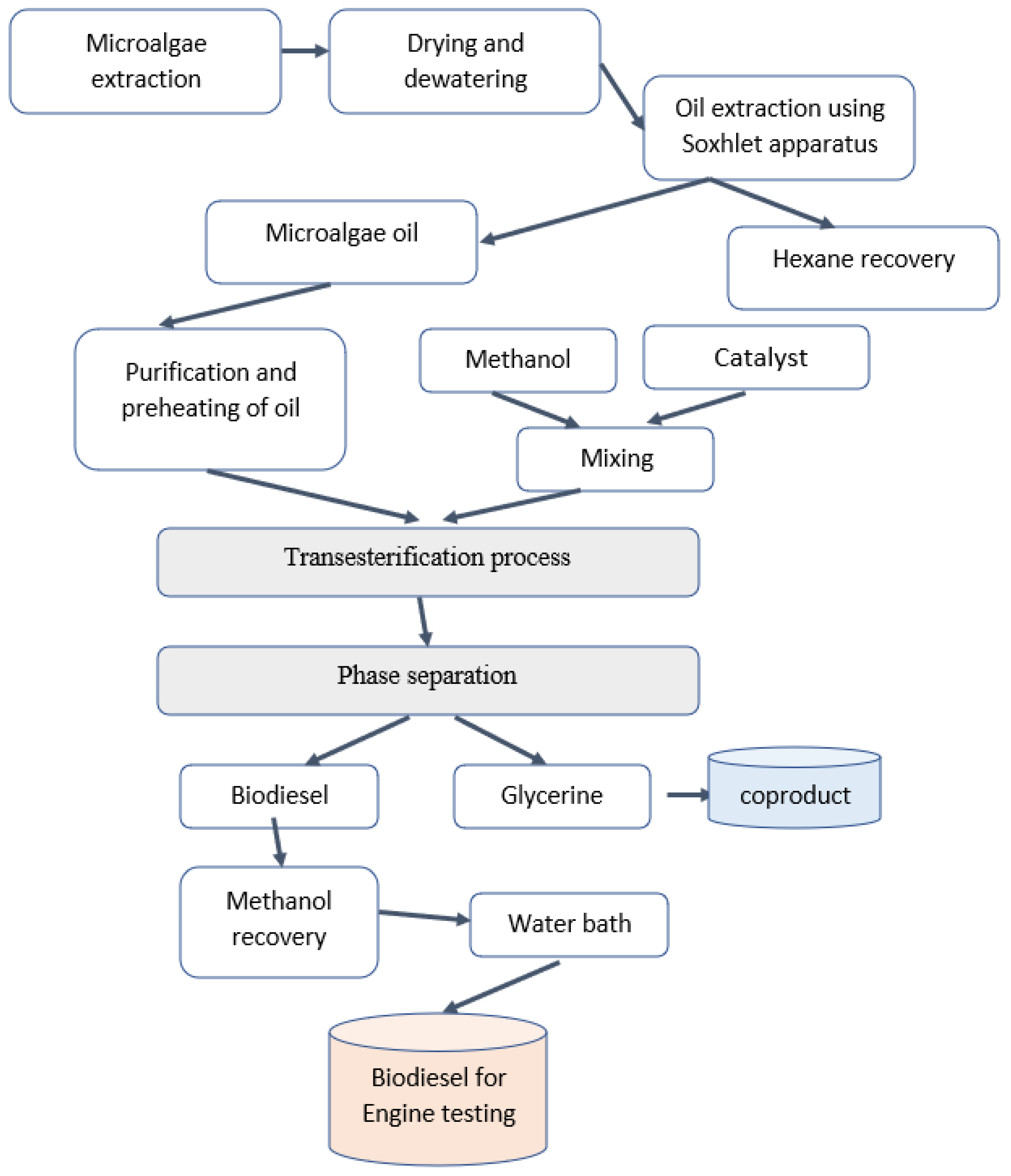


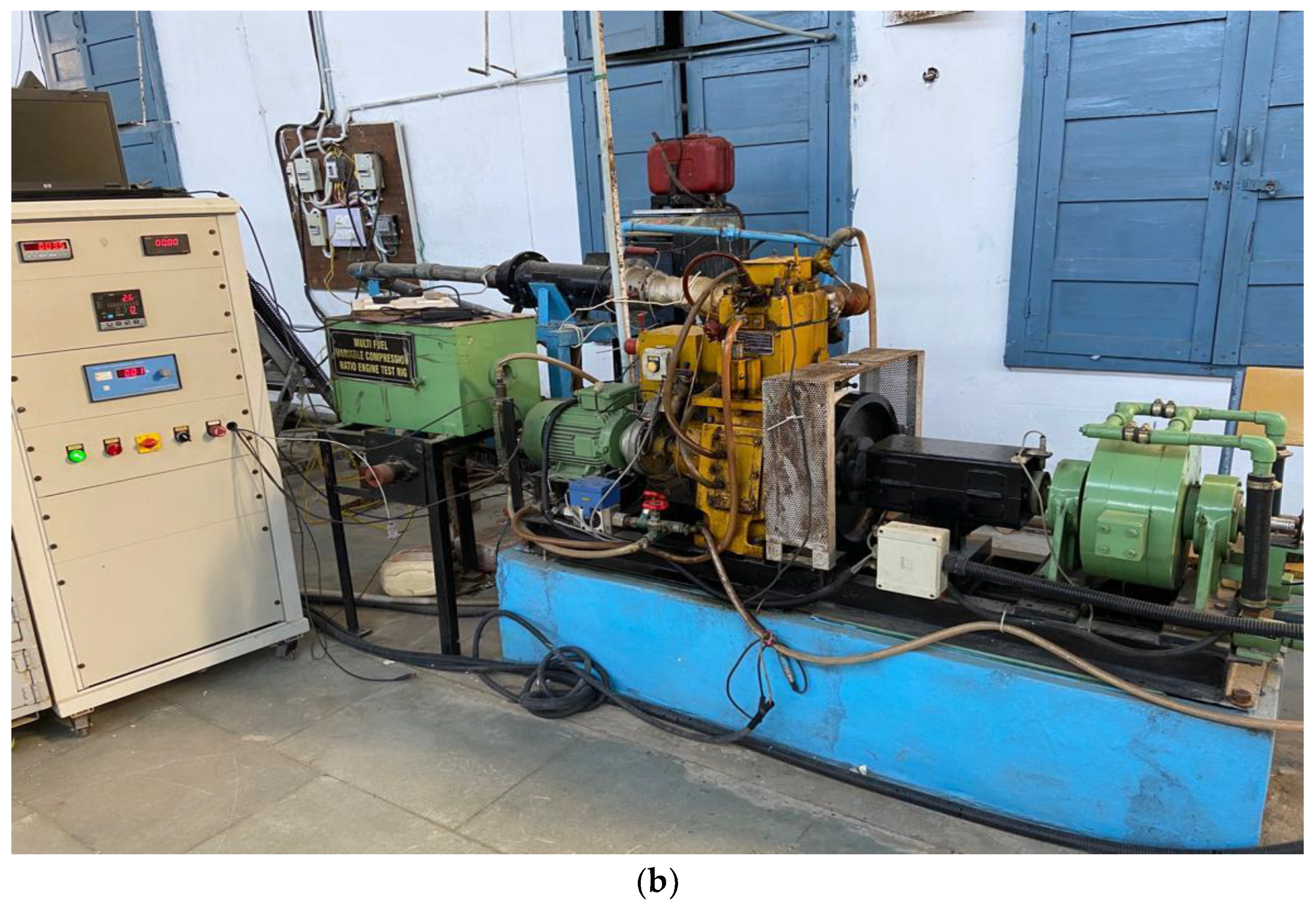
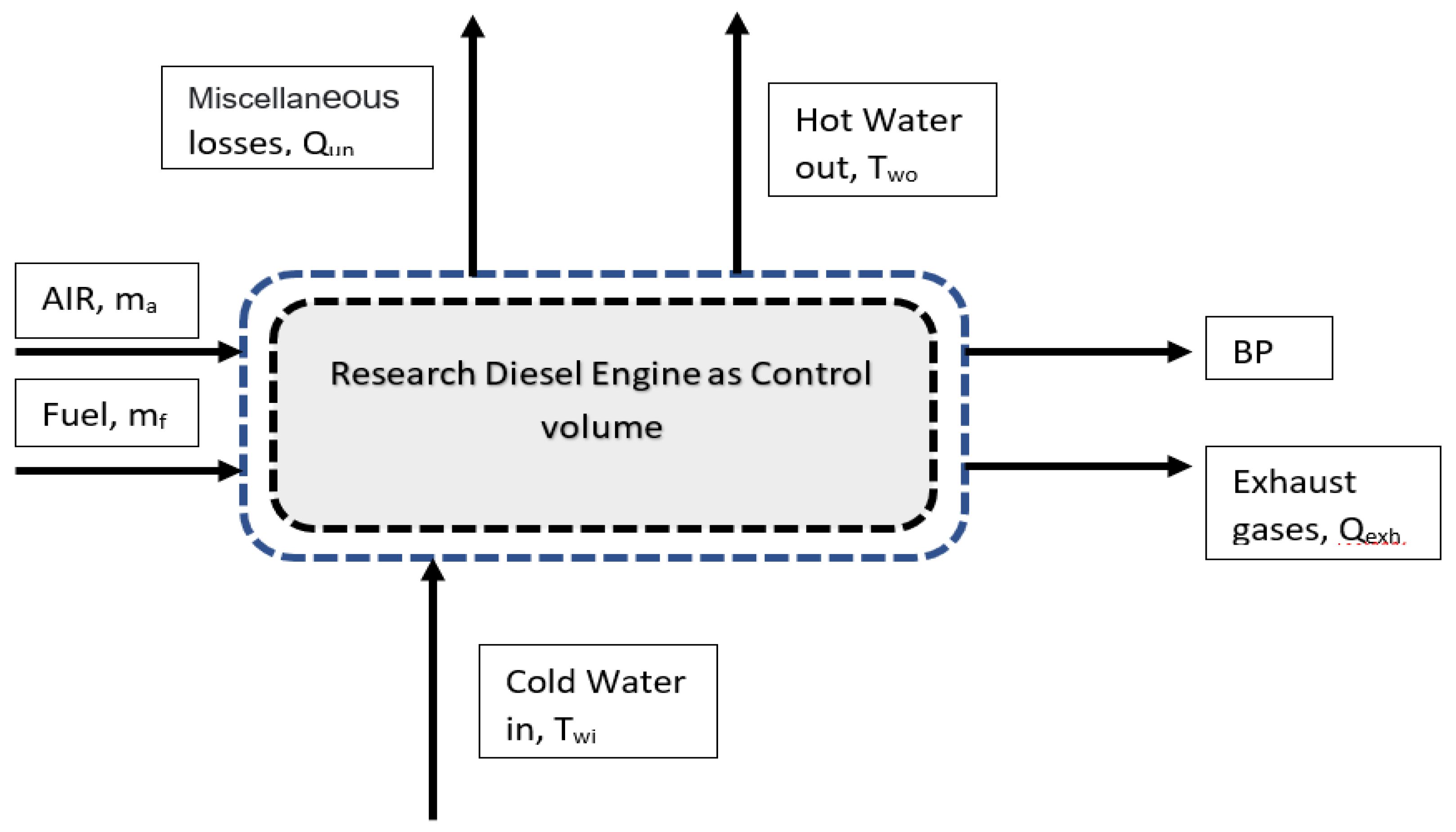
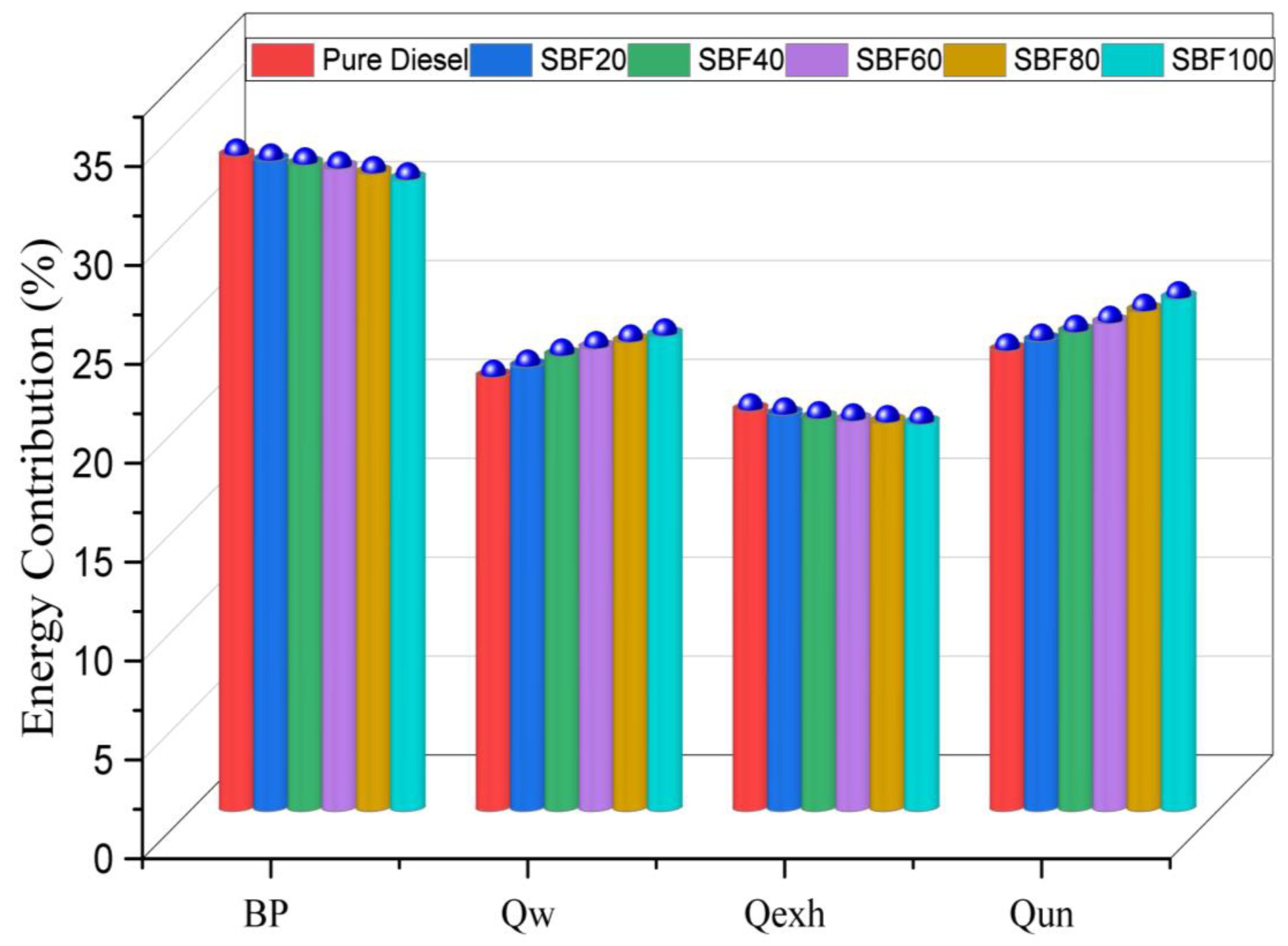

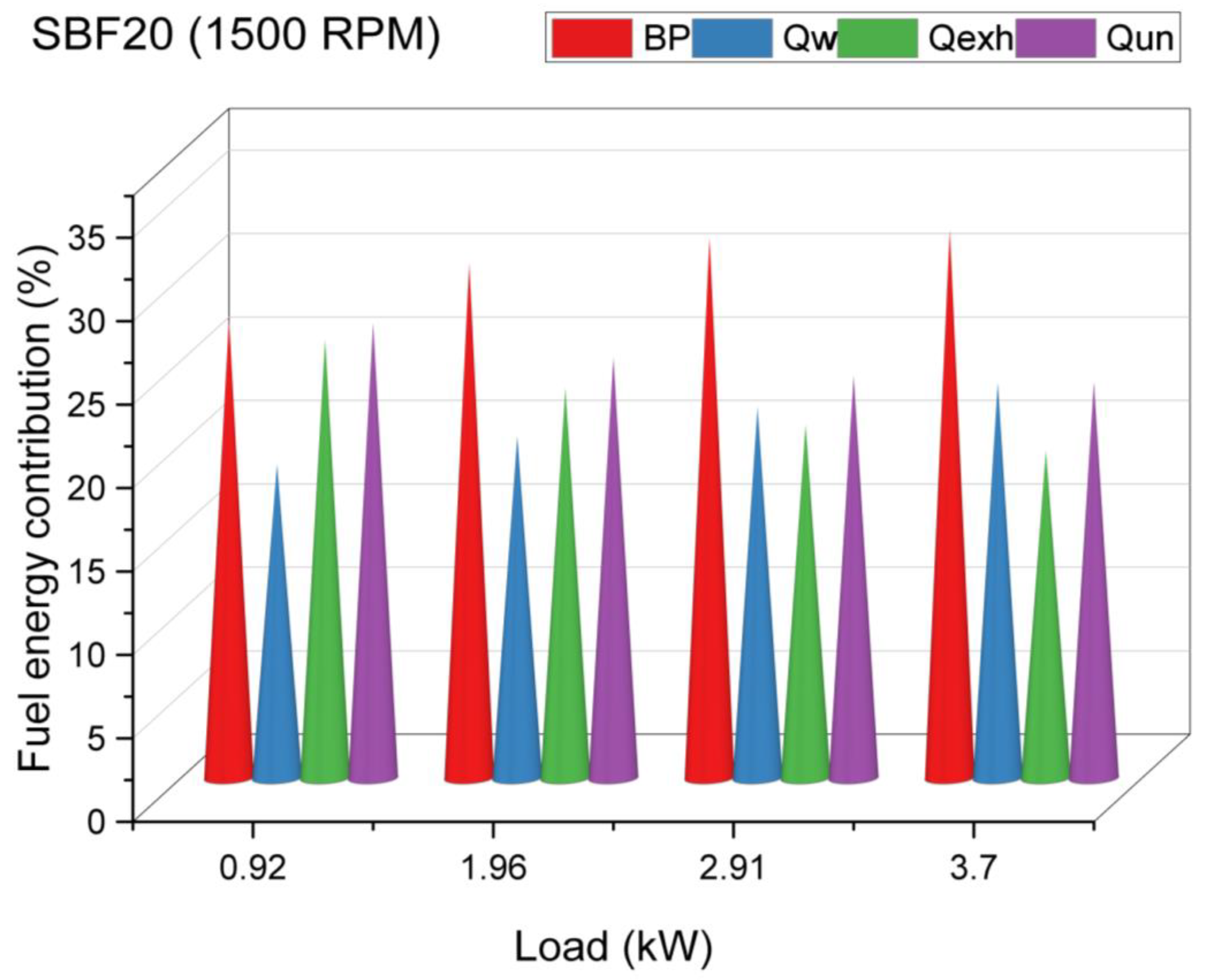




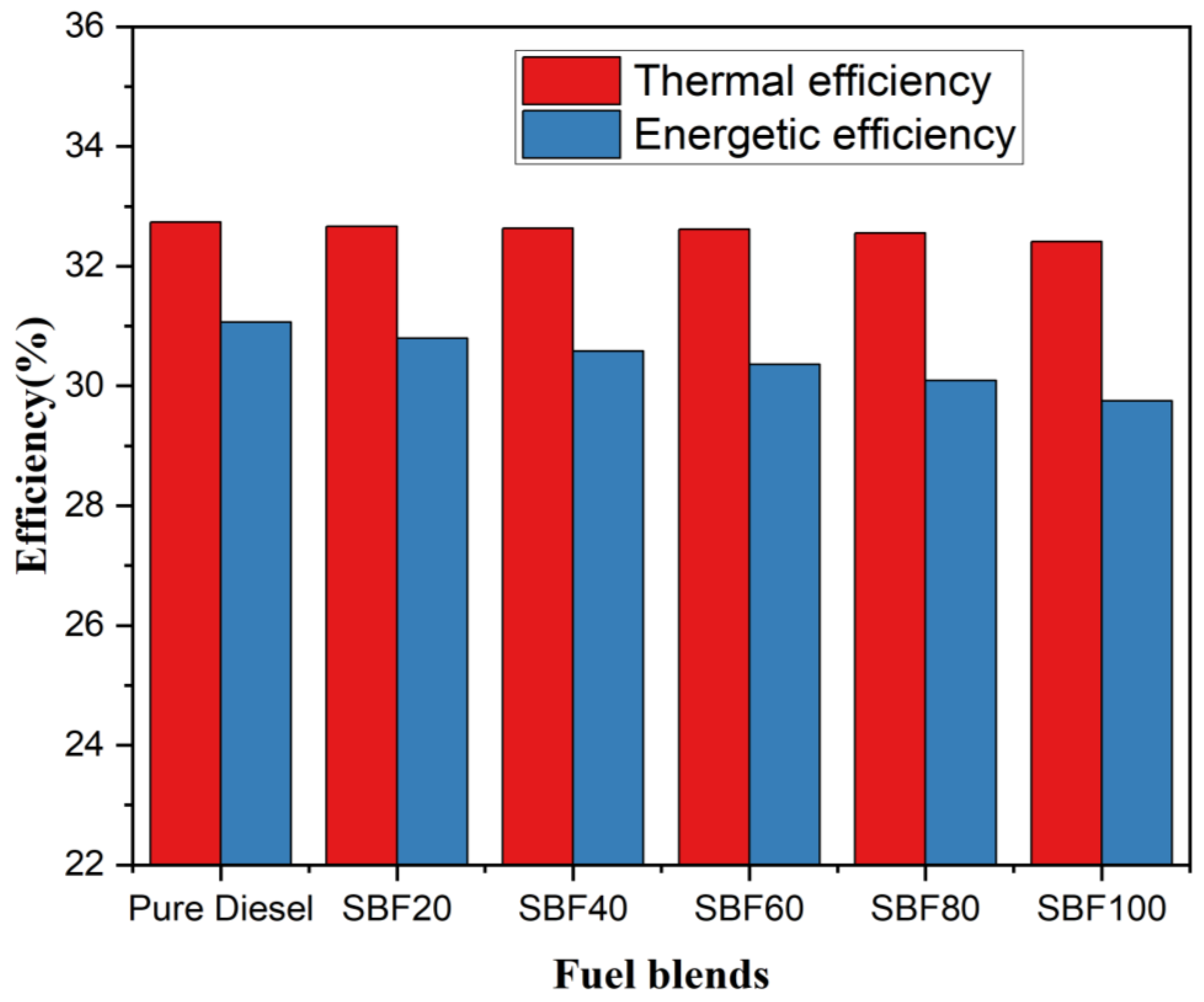


| Reference | Speed (rpm) | Rated Power (kW) | Type of Fuel Blends | Engine Type | Observation Taken for | Exergy Efficiency (Max) | Thermal Efficiency (Max) | Sustainability Index (Max) |
|---|---|---|---|---|---|---|---|---|
| The present study | 1500 | 3.7 | Diesel, microalgae-based biodiesel. | Kirloskar, ¼, DI engine 80 × 110 mm × mm compression-ignition, single cylinder, | 25, 50, 75, and 100% (0.92, 1.96, 2.92 and 3.7 kW) | 31.06% | 32.7% | 1.46 |
| Romas et al. [31] | 1800 | 188 | Natural gas, Diesel, and dual fuel | commercial engine (Cummins 6CTA), with mechanical power of 188 kW @ 1800 rpm, coupled to an electric generator Onan Genset of 150 kW. | 10 kW to 150 kW | 32.6% diesel and 51.7% dual fuel | 35% diesel and 53% dual fuel | - |
| Lopez et al. [28] | 2250 | 34 | Olive pomace oil and diesel blend | direct injection diesel engine Perkins AD 3–152 and 18.5:1 compression ratio | Full load with speed variation 1300–2250 RPM | 24.27 | NA | - |
| Bengi et al. [34] | 2700 | 68 (91 hp) | Diesel, hazelnut biodiesel, and canola biodiesel fuels. | Mitsubishi Canter 4D31 Direct injection diesel with glow plug, 3298cc | At constant load with 1500, 1800, 2100 and 2400 RPM | 36.45% | 38.85% | 1.43 |
| Karthickeyan et al. [32] | 1500 | 5.2 | Methyl ester of Pumpkin seed oil (B1) and Moringa oleifera oil (B2) | Kirloskar/TV1 Direct injection, water cooled, vertical, diesel, naturally aspired engine 01/04 5.2 kW 87.5/110 Compression Ignition (CI) 17.5:1 210 bar | combustion chamber bowl geometry modification 20, 40, 60, 80, 100% load | 64.82%, 66.35% and 63.1% respectively for diesel B1 and B2 | 33.52%, 32.7% and 31.9% for diesel, B1 and B2 respectively. | - |
| Abhishek et al. [35] | 1500 | 3.6 | blends of Diesel-ethanol and Pongamia methyl ester (PPME) | Kirloskar, Model TV-1, 4 stroke Water cooled, VCR Engine.87.5 mm and 110 mm | 20, 40, 60, 80, 100 and 120% | 30.09% | 31.80% | - |
| S No | Crop | Oil Yield (Liters per Hectares) |
|---|---|---|
| 1 | Corn | 172 |
| 2 | Canola | 1190 |
| 3 | Coconut | 2689 |
| 4 | Cotton | 325 |
| 5 | Castor | 1307 |
| 6 | Camelina | 915 |
| 7 | Jatropha | 1892 |
| 8 | Hemp | 363 |
| 9 | Palm | 5950 |
| 10 | Microalgae (high oil content) | 136,900 |
| 11 | Microalgae (low oil content) | 58,700 |
| 12 | Microalgae (medium oil content) | 97,800 |
| 13 | Mustard | 572 |
| 14 | Rapeseed | 974 |
| 15 | Soybean | 446 |
| 16 | Sunflower | 1190 |
| Fatty Acid Name | Chemical Name | Composition (by wt%) |
|---|---|---|
| Lauric acid | C12:0 | 0.67 |
| Mystic acid | (C14:0) | 22.73 |
| Plamitic acid | (C16:0) | 49.28 |
| Palmitoleic acid | (C16:1) | 2.81 |
| Stearic acid | (C18:0) | 5.32 |
| Oleic acid | (C18:1) | 2.44 |
| Linoleic acid | (C18:2) | 5.71 |
| Linoleuic acid | (C18:3) | 7.89 |
| Gondoic acid | (C20:1) | 1.06 |
| Eicosadienoic acid | (C20:2) | 2.09 |
| Blending Ratio | Density at 15 °C (kg/m3) | Viscosity at 40 °C (mm2/s) | Cetane Number | Lower Heating Value (MJ/kg) |
|---|---|---|---|---|
| Pure Diesel | 830 | 2.6 | 48.52 | 42.50 |
| SBF20 | 836.17 | 3.03 | 49.26 | 42.28 |
| SBF40 | 842.26 | 3.54 | 49.97 | 42.05 |
| SBF60 | 848.25 | 4.14 | 50.67 | 41.82 |
| SBF80 | 854.17 | 4.84 | 51.34 | 41.59 |
| SBF100 | 860 | 5.66 | 52.00 | 41.36 |
| S. No. | Parameters | Specifications |
|---|---|---|
| 1 | Engine | 1/4, DI engine |
| 2 | Bore × stroke | 80 × 110 mm × mm |
| 3 | Connecting rod length | 235 mm |
| 4 | Compression ratio | 17.5 |
| 5 | Maximum power | 3.7, kW |
| 6 | Fuel injection pressure | 220 bar |
| 7 | Injection timing | 23.5° b TDC |
| 8 | Dynamometer | Eddy current |
| Source | Sum of Squares | df | Mean Square | F-Value | p-Value | |
|---|---|---|---|---|---|---|
| Model | 25.17 | 9 | 2.8 | 41,217.33 | <0.0001 | significant |
| A-load | 1.6 | 1 | 1.6 | 23,536.72 | <0.0001 | |
| B-Blend | 0.0056 | 1 | 0.0056 | 82.34 | <0.0001 | |
| AB | 0.0049 | 1 | 0.0049 | 72.39 | <0.0001 | |
| A ² | 0.037 | 1 | 0.037 | 545.32 | <0.0001 | |
| B ² | 0.0013 | 1 | 0.0013 | 19.1 | 0.0006 | |
| A ²B | 0.0033 | 1 | 0.0033 | 48.13 | <0.0001 | |
| AB ² | 0.0007 | 1 | 0.0007 | 10.44 | 0.006 | |
| A ³ | 0.0011 | 1 | 0.0011 | 16.94 | 0.001 | |
| B ³ | 0.0003 | 1 | 0.0003 | 4.15 | 0.0611 | |
| Residual | 0.0009 | 14 | 0.0001 | |||
| Lack of Fit | 0.0003 | 13 | 0 | 0.0397 | 0.9998 | not significant |
| Std. Dev. | 0.0082 | R² | 1 |
|---|---|---|---|
| Mean | 3.23 | Adjusted R² | 0.9998 |
| C.V.% | 0.2547 | Predicted R² | 0.9997 |
| Adeq Precision | 562.7536 |
Disclaimer/Publisher’s Note: The statements, opinions and data contained in all publications are solely those of the individual author(s) and contributor(s) and not of MDPI and/or the editor(s). MDPI and/or the editor(s) disclaim responsibility for any injury to people or property resulting from any ideas, methods, instructions or products referred to in the content. |
© 2023 by the authors. Licensee MDPI, Basel, Switzerland. This article is an open access article distributed under the terms and conditions of the Creative Commons Attribution (CC BY) license (https://creativecommons.org/licenses/by/4.0/).
Share and Cite
Tiwari, C.; Verma, T.N.; Dwivedi, G.; Verma, P. Energy-Exergy Analysis of Diesel Engine Fueled with Microalgae Biodiesel-Diesel Blend. Appl. Sci. 2023, 13, 1857. https://doi.org/10.3390/app13031857
Tiwari C, Verma TN, Dwivedi G, Verma P. Energy-Exergy Analysis of Diesel Engine Fueled with Microalgae Biodiesel-Diesel Blend. Applied Sciences. 2023; 13(3):1857. https://doi.org/10.3390/app13031857
Chicago/Turabian StyleTiwari, Chandrabhushan, Tikendra Nath Verma, Gaurav Dwivedi, and Puneet Verma. 2023. "Energy-Exergy Analysis of Diesel Engine Fueled with Microalgae Biodiesel-Diesel Blend" Applied Sciences 13, no. 3: 1857. https://doi.org/10.3390/app13031857






